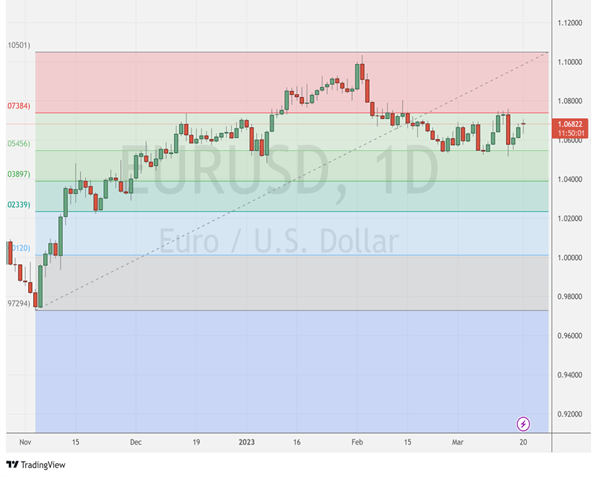EURUSD Prices, Charts, and Analysis
- EUR/USD starts the week in cautious fashion
- UBS’ deal to buy troubled Credit Suisse has the market on contagion-watch
- Key retracement support for EUR/USD is in focus
Recommended by David Cottle
Trading Forex News: The Strategy
The Euro started a new trading week in a very nervous fashion on Monday, with the banking sector’s woes much on market minds.
Switzerland’s biggest lender, UBS AG, has reportedly agreed to buy troubled national rival Credit Suisse for $3.2 billion, assuming substantial losses from the latter. Coming after the collapse of Silicon Valley Bank and the rescue of First Republic Bank by major lenders in the United States, the financial sector is taking a beating on the global stock market and broad risk appetite is fading with it.
The US Federal Reserve has said it will act in concert with other major central banks to ensure liquidity across global banking. This is a welcome move, to be sure, but brings with it uncomfortable echoes of financial crises past, and clearly has market participants wondering whether any more banking dominoes are going to fall.
The boost given to the single currency by last week’s half-percentage-point interest-rate rise from the European Central Bank, with strong hints of more increases to come, has faded for now as European stock markets wilted at the open, following Asian bourses lower.
The move lower Monday morning came after the worst week so far this year for European stocks.
The coming week’s main scheduled economic event will come not from Europe but from the US. The Fed will announce its March monetary policy decision on Wednesday. The Federal Open Market Committee is expected to increase borrowing costs for the ninth meeting in a row, despite turmoil in the banking sector, with a quarter-percentage point rise expected.
The Fed continues to grapple with the same problems besetting other central banks as economic activity weakens and inflation remains stubbornly high. Eurozone consumer prices were rising at an annual rate of 8.5% in February, barely changed from the previous month. The ‘core’ measure which strips out the volatile effects of food and fuel, rose by 5.6%, beating January’s 5.3%. The ECB’s officially-mandated inflation target is just 2%.
EUR/USD Technical Analysis
Chart Compiled Using TradingView
Recommended by David Cottle
How to Trade EUR/USD
EUR/USD’s impressive uptrend from the lows of November last year is clearly under some pressure now, if it doesn’t turn out to have been conclusively broken by late February’s weakness.
Euro bulls held on around 1.07384, the first Fibonacci retracement of the rise up from those November lows to the ten-month peaks scales in February of this year, but finally abandoned it on February 15. That level is now important resistance, having kept those bulls in check on two occasions in the past week.
They will need to recapture the level and form a base there if they’re going to have another run at the February highs, but that looks like a big ask, at least in the near term.
That said, IG’s sentiment index finds the market bearish toward the Euro at current levels, but only very modestly so with a bull/bear split of 51%/49%.
Support for the pair comes in very clearly at the second Fibonacci retracement, 1.05456. The Euro has bounced there three times since February 24, and the bears were held there again in early January. So it’s reasonable to assume that a fall through that level would only increase pressure on the Euro.
–By David Cottle for DailyFX
|
|



Leave a Reply
You must be logged in to post a comment.